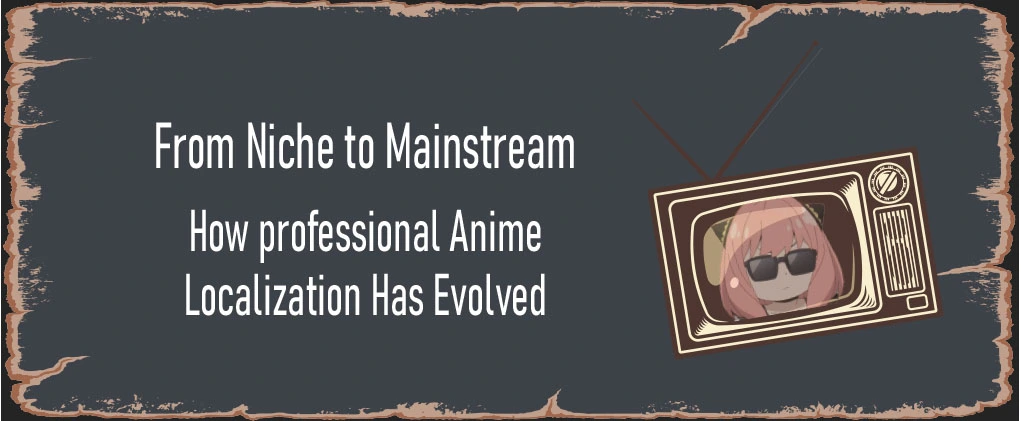From Niche to Mainstream: How Professional Anime Localization Has Evolved
The digital revolution and the growing appreciation for Japanese culture bring about the growing demands for professional anime localization. Watching anime started from a niche interest of a few to becoming a mainstream interest, as anime content not only caters to the younger kids but to the adults, as well. With the constant evolution of the merchandise market and the fast-growing content genres, anime translation and localization is a service that will continue to flourish.
Anime went from niche to mainstream because of localization. The Millennials handed down the same fan culture to Gen-Z, which included a love for anime and Japanese culture. Furthermore, accessible technological advancements increased the possibilities of scanlations or fanmade translations.
Anime localization services like CCCI can help in bridging cultural and language barriers. For example, Japanese-to-English anime localization can make anime more appealing to non-Japanese audiences. Learn more about how Japanese anime translation services have evolved from niche to mainstream, and how anime localization companies can help you in localizing your own works.
Key Takeaways
- The digital revolution and the growing appreciation for Japanese culture bring about the growing demands for professional anime localization.
- Early anime localization efforts overcame challenges, leading to a learning curve that fueled the growth of the anime market.
- The emergence of translation services, equipped with skilled translators and cultural consultants, has improved the accuracy of the materials, as well as the adaptation from one language to another.
- The rise of streaming platforms created high viewer expectations, leading to a demand for quick localization and releases.
- Amidst controversies over localization and AI, anime services should prioritize quality by practicing augmented intelligence and cultural integrity.
Table of Contents
- Early Stages of Anime Localization
- Professionalization of Anime Localization
- Techniques in Modern Anime Localization
- The Role of Streaming Platforms and Global Demands
- Future Trends in Anime Localization
- CCCI: Professional Anime Localization and Subtitling Services
Early Stages of Anime Localization
Long before the realities of localization in anime that we presently know, there were several ways of releasing anime in countries outside of Japan. Particularly, during the 1960s to 1980s, licensing and dubbing shows to release anime in other countries was the norm. Astro Boy became the first animated Japanese show that was broadcast worldwide, which marked the beginning of the present-known anime.
From the 1990s to the early 2000s, localization evolved as anime was booming in the United States. Actions included romanizing names, localizing episode titles, adapting humor, editing content to fit the target, and even altering translations to match cultural differences. During this time, pirated distributions and fansubbers were more mainstream, yet with the introduction of digital streaming services, the former ways declined.
Challenges and Impacts
Amidst the advantages and benefits of localization, especially during the earlier stages, it also received a bad reputation among viewers. First, piracy and fansubs initially led to poor-quality localization, resulting in inaccurate cultural adaptation due to the lack of direct comparisons between cultures. Moreover, unnatural translations, as there are often no direct word-to-word translations, dilute the meaning in the process.
The challenges that localization in anime faced led to the dissatisfaction of some audiences. Several online forums have included audience opinions on how the poor quality of localization misrepresented the culture of the original material. Furthermore, some audiences felt that the value of their beloved anime shows deteriorated because of incorrect dubbing and excessive censorship.
Learning Curve
However, these challenges and subsequent impacts can be turned into learning curves, especially for anime production companies and manga artists. Dynamic and continuous learning is needed in the localization and translation process in anime, which includes being updated with the current trends and undergoing relearning and unlearning as well.
Change is inevitable, and this was evident in how language and culture, regardless of the country, are evolving constantly. Audiences and consumers also change media preferences over time. That is why keeping up with the trend is just as important as the abovementioned.
Professionalization of Anime Localization
Partnering with Japanese anime translation services, big production companies with access to free television became the first to localize anime. Nowadays, many companies offer professional anime localization services, as well as anime translation services, like CCCI, which help further the popularity of anime.
In recent years, the accessibility of modern tools enhanced subtitling and dubbing. Before this, there had been a longstanding debate within the community about which was a better pick: the subs or the dubs. And because of the anime market growth, higher budgets were allocated for translation and even voice acting to improve the quality and therefore, attract more audience.
With that being said, the emergence of such translation services, equipped with skilled translators and cultural consultants, has improved the accuracy of the materials, as well as the adaptation from one language to another. The increased quality has attracted more audience and improved engagement.
Techniques in Modern Anime Localization
It is expected that modern professional anime localization entails high-quality materials. To ensure this, we have listed here some of the best practices in translation and localization.
Subtitling and Dubbing Practices
Before producing the subtitles and dubs of a show, it is important to understand the source material first. Knowing the purpose and genre of a show would give the translator a general idea of how they would map out the entire process. Knowing the target audience is also important for creating a relevant translation that resonates with the audience.
Timing and synchronization are crucial when it comes to subtitling and dubbing. Establish the technicalities clearly and understandably while maintaining the character limits and exact pacing.
For subtitles, it should not be words that should be translated, but the meanings of the dialogue. It is also important that the lines are of optimal length, to keep up with the characters’ dialogue and is readable enough for the audience. A speaker ID is also favorable, especially in dialogue scenes, to clarify which character is speaking.
For dubbing, the dialogue should be synchronized with the lip movement of the characters. Choosing native-speaking voice talents, depending on the translated language, ensures clear enunciation and authenticity. Investing in high-quality recording equipment and experienced sound engineers would further enhance the quality of the dubs.
Cultural Adaptation Choices
Cultural considerations are crucial when localizing an anime. Understanding the target audience’s cultural background, as it may differ from that of the source material, is important. Localization should aim to adapt content, making it culturally relevant to the new audience.
To explain it further, cultural nuances like humor, slang, and other references must be cross-checked between the source material and the target language. Research what humor and references that are more relatable to the target readers. Identify if there ever are terms that may come across as taboo or inappropriate for them.
Remember that in translating and localizing, changes are fine as long as they still point to the meaning. It is also acceptable not to directly translate lines as it may come up as unnatural or robotic. Lastly, proofreading, editing, review, and feedback should always be done to ensure the highest quality in translation and localization.
Pro-tip: In Japanese anime localization and translation, working with native speakers and cultural consultants ensures the authenticity of the localized piece.
The Role of Streaming Platforms and Global Demand
Streaming platforms, like Netflix and Crunchyroll, have aided in the global distribution of animes in the 21st century. Such platforms were patronized by viewers as they offered convenient access to various on-demand shows. These platforms made local animes more accessible to the international scene through a wide range of available languages and professional anime localization.
Netflix’s success in the streaming industry teaches us a thing or two about its localization strategy. They are not only focusing on the aspects of translation and localization, but they also specialize in technology and media. Crunchyroll, which focuses more on streaming anime and Asian shows, is considered one of the top anime streaming platforms, as it currently has the largest catalog in the anime genre and is available in over 200 countries.
As shows become readily available through these streaming platforms, viewers cultivated high expectations for these platforms to release more. This then led to a need for rapid localization and swift releases.
Future Trends in Anime Localization
Currently, professional anime localization is headed for a wider audience reach. While there is a growing demand for translators, some production companies also started to utilize AI for localization and translators. It is important to keep the balance between the involvement of humans and AI.
As the anime market grows, there is a demand for more shows to be translated and localized. Resulting in rapid localization timelines and issues with fan translations, it further leads to poor localization.
Along with this, there is a growing demand for accuracy and authenticity among the audience. Translators should strive for more accurate and culturally sensitive translations to keep up with the changing audience demands.
Anime continues to reach the status of becoming a mainstream genre. Amidst the controversies gravitating around poor localization and AI application, anime localization services should always aim to produce higher-quality shows that practice augmented intelligence and preserve cultural integrity.
CCCI: Professional Anime Localization and Subtitling Services
Ultimately, anime shows transitioned from being a niche interest to mainstream media. If you are interested in having your manga and anime translated and localized to reach a global audience, CCCI is your go-to anime localization company! Get in touch with us.






